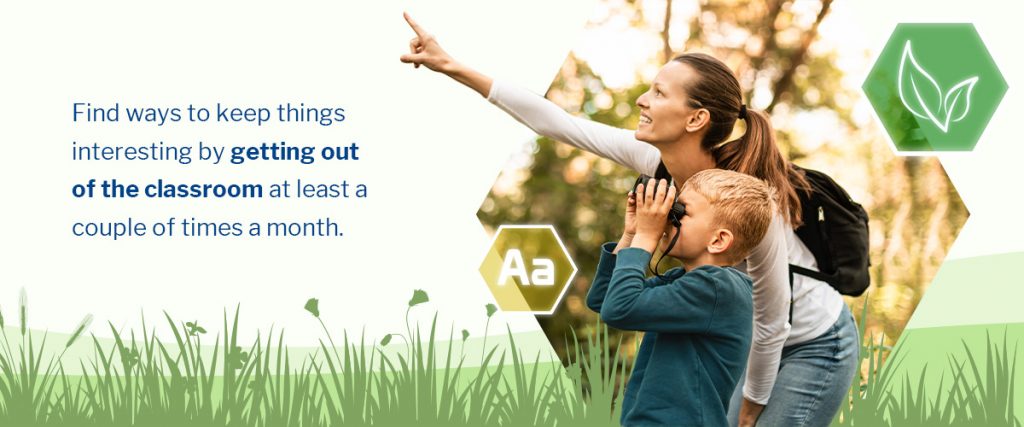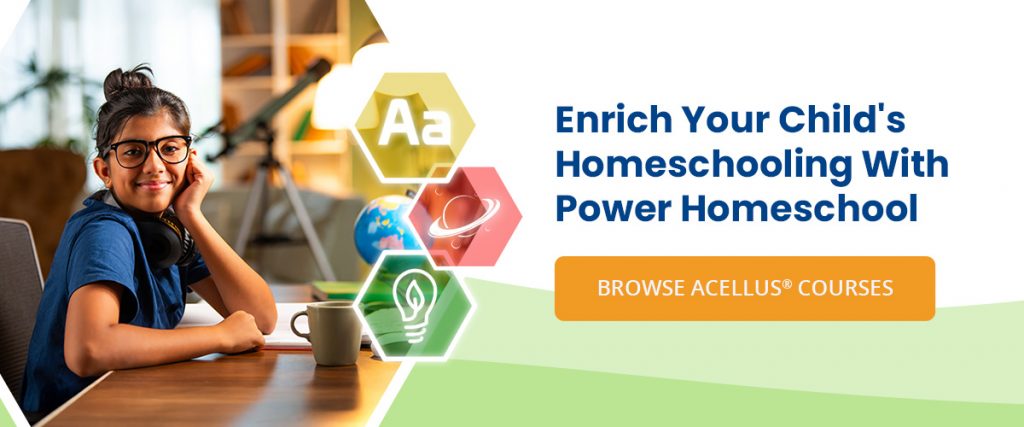Teaching your children at home can be an immensely rewarding experience. One of the reasons that many parents choose to homeschool their kids is that they feel they can provide a better education for their children than either a public or private school. To provide an outstanding education for your children, you will need to provide an environment that fosters learning. Power Homeschool has a few tips for creating a learning environment at home for your children.
1. Make a Special School Space
While it can be tempting to set up shop at the dining room table or on the couch, these areas aren’t the most conducive to learning. Creating a dedicated learning space can make it easier for children to concentrate on schoolwork.
When it comes time to make a special place just for school, consider a room that is large and open. Consider what all you will need in the room. You will need a place for students to work; often, parents choose a table or desks. Learning centers are important for homeschooling environments, and bookshelves are a great place to store reading and learning materials. Don’t forget that you will need a lot of storage space in this room, so you are going to need a lot of room for everything.
Make sure your children’s dedicated learning space is used only for schoolwork. Using the area as a playroom or lounging space may negatively impact your kids’ focus during the school day. You might also notice that supplies dwindle or vanish when the room is used for play or other activities.
2. Make Your Space Comfortable
Your homeschool room setup should be comfortable to ensure your children aren’t distracted by their discomfort. Try to choose a room that is well-insulated with good airflow. If this is not possible, install an air conditioning system or heater so you can control the temperature.
Windows that allow natural light into the room can be beneficial, but you might want to install blinds or curtains if the room is in direct sunlight, as direct sunlight can make the room very warm. Additional seating options like carpets, yoga balls or beanbags can also increase comfort.
3. Make Your Space Visually Appealing
Consider setting up a homeschool room that is inviting and encourages engagement. This might include painting the walls with fun colors and decorating with educational posters, school project artwork, furniture and throw pillows. Allow your children to play a role in decorating by encouraging them to make art pieces and paint walls.
While the homeschool setup should make your children feel inspired and safe, avoid putting up decorations that are too distracting and hinder the learning environment.
4. Create a Place for Supplies
Make an area for the basic school supplies. If your kids have to go on a five-minute hunt every day for a pencil, that will eat away at precious time and cause a big distraction. Make sure that there is a well-stocked supply station in your classroom to avoid constantly searching for simple things throughout the day.
You can keep things like rulers, staplers, markers, and other items that might not be used as often in a supply cabinet or station. Get creative with labels and keep the space organized.
Don’t forget to create an area for all of the teacher items. If you want to keep your supplies separate from the regular classroom supplies, then make your own little space in the classroom. If you have your own desk, you can store most of your things in your desk for safekeeping. Consider getting chalkboards and markerboards to use in your schoolroom. If you really want to get creative, you could use chalkboard paint to make a wall your chalkboard.
5. Don’t Forget to Get Out of the Classroom

While you will likely spend a lot of time in your homeschool classroom, don’t forget to take the opportunity to get out of the classroom from time to time. Maybe you do class outdoors on a nice day. Perhaps you can do a lesson in the kitchen or do some reading on the couch. You may even be able to get out of the house altogether and learn while in the park or at the grocery store. Find ways to keep things interesting by getting out of the classroom at least a couple of times a month.
Some homeschool parents create a little area outside to use on nice days. Get quality furniture that your children can do schoolwork from. We recommend getting solid furniture so that the tabletop can be a good writing surface. You can also take the time to plant a garden to use as a lesson and a fun place to go when it is just too nice to sit inside during the day.
While it is a good idea to get out of the classroom occasionally, it isn’t a good idea to allow your children to complete their work in their bedrooms frequently. A lot of distractions can pop up in their bedroom, which isn’t going to be conducive for their education.
6. Leave Time for Breaks
Consider the best times for your children to take breaks. This will often be when they start to get restless or hungry. Spend the first few days evaluating when their energy levels get low and schedule breaks during these times to help them recharge. Think about incorporating a short play break a few hours after lunch or a morning snack break.
While some children might require frequent short breaks, others might like only one or two longer breaks. Read your children and let them help create your schedule in this matter.
7. Keep the Room Clean
Clutter and stray items can be distracting for young learners. Keep the homeschool setup clean and organized by packing everything away at the end of the school day. To reduce clutter, only take out the equipment needed for the day. Teach your children to join you in keeping the room clean.
You can have your children help in this task regardless of age. Teaching your kids to put away items when they are done with them is a great way to make sure that your classroom doesn’t get really messy.
8. Celebrate Achievements
Reward your children when they make small or big achievements. Rewards help boost motivation and build good learning habits, creating a more positive educational environment. This builds their confidence over time, encouraging them to continue doing their best.
Set goals with your kids so that they know what to work toward. Some reward ideas might include extra screen time, 10 minutes added to their break or their favorite snack.
9. Create Routines
Routines create a good learning atmosphere by adding security and stability to students’ days. When students know what to expect, they can focus and avoid concerning themselves with what comes next. Add structure and control to your child’s day by creating a routine with them that maintains their attention.
A consistent routine can include waking up, starting school, ending the school day and going to bed at the same time each night. It also helps them to do their homework and enjoy screen time at set times during the day.
10. Encourage Reading
Reading at home can help children develop important intellectual skills that can enhance critical thinking and communication. Some skills children can develop from reading include improved vocabulary, concentration, listening comprehension, creativity, emotional maturity and problem-solving.
Lead by example by reading books yourself during your free time. Be sure to give them access to children’s books, and consider visiting the library and reading bedtime stories together as part of your nightly routine.
Enrich Your Child’s Homeschooling With Power Homeschool
One of the best things you can do for your children as a homeschooling parent is to provide them with the resources and environment they need to be productive and motivated throughout the day. Power Homeschool helps parents do this with hundreds of Acellus® courses and additional resources for children through grade 12.
To learn more about homeschooling, visit our parent blog for more homeschooling tips and browse our available Acellus® courses today.




Thanks for your awesome article. Even as schools open, many are still using a mix of synchronous and asynchronous teaching, so that proper place to learn while at home is certainly critically important.
I’m considering to subscribe my child to this program it seems very interesting ?